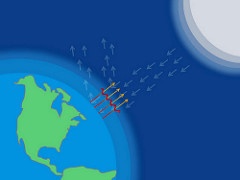 The Government of Ontario has announced that it is moving forward with a Greenhouse Gas Cap and Trade program that will directly impact the operation of manufacturers across the province. Ontario will also be linking its cap and trade program with the GHG cap and trade markets in the province of Quebec and the state of California.
The Government of Ontario has announced that it is moving forward with a Greenhouse Gas Cap and Trade program that will directly impact the operation of manufacturers across the province. Ontario will also be linking its cap and trade program with the GHG cap and trade markets in the province of Quebec and the state of California.
The landmark climate change legislation enters Ontario manufacturers into the North American carbon market comes into force July 1, 2016. Manufacturers in the chemical, automotive, aerospace, and other manufacturing sectors should expect to have new greenhouse gases reporting compliance requirements in their air emissions tracking and reporting, including:
- A cap on Greenhouse gas emissions.
- Compliance requirements and periods.
- New market rules for selling and buying carbon credits.
- Some businesses will be required to participate in the new carbon market, while others will have the option to buy or sell carbon credits.
What Does the Carbon Cap and Trade Mean for Your Enterprise?
If your processes generate Greenhouse Gases, you would be required to accurately track your GHG emissions and be able to account for the total type and quantity and then convert into a common unit of Carbon Dioxide equivalents (CO2e) units.
If your GHG emissions are below your permitted level, you would accrue excess carbon credits which could be sold to other businesses to reduce your overall operating costs. In contrast, if you emit GHG releases in excess of your permit, you would be required to purchase carbon credits from another business. This means that you are essentially paying to emit, and each ton of CO2e costs dollars from your bottom line.
In this way, the Ontario Carbon Cap and Trade operates the same as the Quebec and California carbon markets.
Regardless of your actual emissions, the new legislation adds to your workload and creates complexity in your EHS management:
- GHGs need to be accurately monitored and tracked from all affected sources.
- Improvements made to greenhouse gas emission reporting.
- Better recordkeeping of GHGs will be required.
- Integrate financial budgets with your EHS activities.
For many, the new Carbon market is a unique opportunity to reduce overall costs. Those enterprises that have already invested in low-emission technologies or better control devices will generate revenue through selling their carbon credits. As such, the increased EHS workload you will be faced with should be viewed as a profit generating endeavor – if you are prepared with the right sustainability technology and tools.
The Government of Ontario has produced this short video to clarify how the new Carbon market will affect you.
The Solution for Your Cap and Trade Needs
Since Cap and Trade presents new challenges, the solution is to ensure you have the tools in place to accurately scope your GHGS emissions and roll that data up into the reports you need to prove compliance with air permits and get the carbon credits you are entitled to.
Manually estimating this data and writing air reports by hand is a sure-fire way to introduce errors that will cost you Carbon credits – ultimately costing you significant dollars. Furthermore, every mistake you make that cheats you out of Carbon credits gives your competition a very real advantage, as they will also be vying to generate profits by selling credits in the new Carbon market.
That’s why ERA has meticulously developed Greenhouse Gas emission tracking and reporting features over the past twenty years that quickly and efficiently roll up the reports you’ll require for the new circular economy and Carbon market. ERA software tracks your stack and fugitive GHG (in addition to HAP/VOC) emissions down to the smallest detail. You’ll get comprehensive roll up reports, KPI benchmarking, and an executive dashboard that tell you how your enterprise is performing. These invaluable tools are essential for identifying initiatives to earn carbon credits and increase revenue.
On top of all that, GHG reports take a fraction of the time when using ERA reporting software. These time savings translate into reduced overhead costs for your EHS department.
See how ERA’s GHG reporting capabilities will put your business at an advantage come July 1 as Ontario enters the North American Carbon Market. Get your free, personalized demo from one of our ERA air emissions experts today.
This Blog Was Co-Authored By:


Tags:
EHS Software
June 6, 2016

Comments